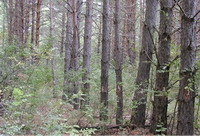Volkova P.E.,
Ovchinnikova
T.M., Soukhovolsky V.G.
V.N. Sukachev
Institute of Forest SB RAS
50 Akademgorodok, 660036, Krasnoyarsk, Russia
Abstract
This
work is dedicated to studying major system attributes of forest
lepidopterous
insects’ pheromone communication channel (i.e. female
behavior strategies,
information losses and noise in the channel, necessary effectiveness of
pheromone communication channel, etc.). These system attributes result
not from
insect species’ peculiarities or pheromone molecule
characteristics, but from
general characteristics of communication channels, considered from the
point of
view of information theory and general patterns of decision making
during
generation and perceiving information.
Keywords: Insects,
pheromons, odor-guided search,
behavior, strategy
References
Belanger J. H.
Behavioral strategies underlying pheromone-modulated fight in moths:
lessons
from simulation studies/ J. H. Belanger, E. A. Arbas // J Comp Physiol
A. 1998.
No.183. P. 345-360.
Brady J. Odor
movement, wind direction, and the problem of host-finding by tsetse
flies/ J.
Brady, G. Gibson, M.J. Packer
//Physiological Entomology. 1989. №14. р.369-380.
Charlton R.E.
Factors mediating copulatory behavior and close-range mate recognition
in the
male gypsy moth,
Lymantria dispar
(L.) / R.E. Charlton, R.T. Carde // Environmental entomology.
– 1995 – P.
1239-1244.
Elkinton J.S.
Pheromone puff trajectory and upwind flight of male gypsy moths in a
forest/
J.S. Elkinton, C. Schal, T. Ono, R.T. Carde// Physiological Entomology.
1987.
№12. р.399-406. http://www.pherobase.com/
Ishida H. Mobile
robot navigation using vision and olfaction to search for a gas/odor
source./
H. Ishida, H. Tanaka, H. Taniguchi, T. Moriizumi // Auton Robot. 2006.
No. 20.
P. 231–238.
Kuwana Y.
Synthesis
of the pheromone-oriented behavior of silkworm moths by a mobile robot
with
moth antennae as pheromone sensors/ Y. Kuwana, S. Nagasawa, I.
Shimoyama, R.
Kanzaki // Biosensors Bioelectronics. 1999. No. 14. P. 195-202.
Lilienthal A.
Gas
source tracing with a Mobile Robot using an adapted moth strategy/ A.
Lilienthal, D. Reimann, A. Zell // Proc. of the AMS 2003. 2003. P.
150-160.
Pyk P. An
artificial
moth: Chemical source localization using a robot based neuronal model
of moth
optomotor anemotactic search/ P. Pyk, S.
Berm´udez
i Badia, U. Bernarde et. al. // Auton Robot. 2006. No. 20.P.
197–213.
Ramaswamy S.B.
Relationship between catch in pheromone-baited traps and larval density
of the
spruce budworm, christoneura fumiferana (Lepidoptera: tortricidae) //
The
Canadian Entomologist. – 1983. – P. 1437-1443.
Rutkowski A.J. A
robotic platform for testing moth-inspired plume tracking strategies/
A.J.
Rutkowski, S. Edwards, M.A. Willis, R.D. Quinn, G.C. Causey // Proc. of
IEEE
International Conference on Robotics and Automation (ICRA 2004). 2004.
Shorey H.H.
Chemical
control of insect behavior // H.H. Shorey, John J. McKelvey.
– USA:
John Wiley&Sons, Inc., 1977. - 414 pp. Бедный
В.Д. Технология применения диспарлюра в лесозащите // В.Д. Бедный.
– Кишинёв:
Штиинца, 1984. – 166 с.
Овчинникова, Т.М. Моделирование
системы феромонного
поиска у лесных чушуекрылых: анализ свойств канала коммуникации и
трансформации
сигнала в шум/ Овчинникова, Т.М., Ковалев А.В., Волкова П.Е.,
Суховольский В.Г.
//
Математическое моделирование в экологии. Пущино, 2009, с.
195 – 196.
Рожков А.С. Сибирский шелкопряд //
А.С. Рожков – М.:
Издательство Академии наук СССР, 1963. – 176 с.
Томилин, Ф.Н. Теоретический анализ
устойчивости молекул
феромонов к факторам внешней среды/ Ф.Н. Томилин, О.В. Осина, Е.В.
Седова, С.Г.
Овчинников, Т.М.Овчинникова// Сложные системы в экстремальных условиях.
– 2008
– С.96-97.
Шикин, Е.В. От игр к играм // Е.В.
Шикин. – М.: Издательство
ЛКИ, 2007. – 112 с.





